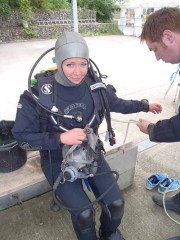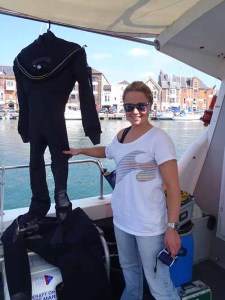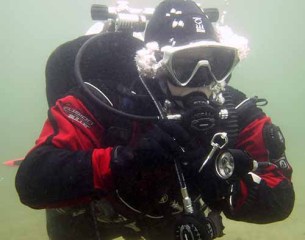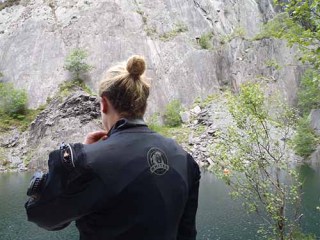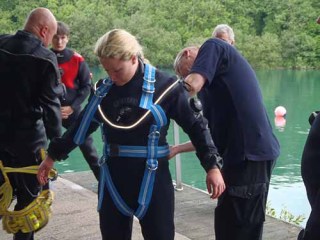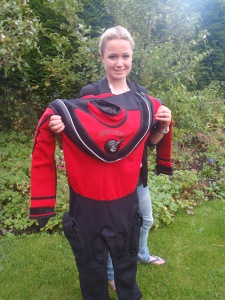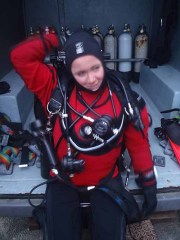Neoprene or membrane? No: It’s a White’s Fusion Bullet…
Established back in 1956, Whites was the first company in North America to produce drysuits. Today, Whites produces what can easily be described as some of the most innovative and distinctive drysuits on the market. The Fusion range – including the Bullet, Sport and Technical – was launched two years ago. Thanks to the range boasting an array of remarkable features it is extremely popular with an assortment of divers. The most notable feature is the use of materials granting a level of flexibility previously unknown to drysuit divers. Indeed Fusion suits are in demand from many recreational, professional, commercial and military divers.
The Fusion range features DryCORE technology, which Whites describe as offering “the ultimate in mobility, warmth and streamlining”. This inner DryCORE layer is a light-weight but resilient shell. An over-suit made from flexible fabric fits neatly over the top, making for a streamlined and stylish suit. The extent to which these suits stretch is evident when you see an empty suit:
A light-weight drysuit that can be easily compacted into a small bag is very beneficial. It makes my life as a travelling Scholar a lot easier. Many people are dubious about the level of warmth and robustness a lightweight suit can offer. Having dived in both the Fusion Sport and the Fusion Bullet, taking them from Northern Scotland to Southern England, I have put these suits through many challenges and I can report they are both warm and robust.
From 6°C-17°C, neither suit has faltered. From my GUE Fundamentals course – which requires a lot of maneuverability – to my HSE Scuba course – which involves a lot of scrabbling around on the bottom – the Fusion suits have been infallible. Not only was I able to move freely and comfortably, I was also warm and dry on every dive. I wouldn’t hestitate to say using a Fusion suit was the reason I managed to pass the GUE course. Having to reach my tank valve in any other drysuit I have worn would have been impossible.
Another great aspect of these suits is their adaptability: they make for a perfect summer suit, and a perfect winter suit. Because they are are both stretchy and streamlined you can go all out and pile on layers of thermal protection, or you can go with minimal thermal protection. The Fusion suits will happily deal with either extreme.
Throughout my summertime UK diving tour I was using the Fusion Sport, which I had kindly been leant while my Bullet was en-route from Canada. Diving out of Weymouth harbour in a drysuit on a hot day could make for one sweaty diver, and a somewhat damp drysuit. However, with merely my Fourth Element Drybases acting as my undersuit, I didn’t overheat as I kitted up for the dives. What’s more I was pleasantly surprised to find I remained warm for the duration of my dives. Alternatively, when descending to the deep and mysterious depths of Vobster Quay, the water temperature drops to 6°C. In these colder conditions all it took was an upgrade from my Fourth Element DryBase to my Fourth Element Arctics to keep warm.
After then spending the majority of September in Egypt, where wearing a drysuit would most likely kill you, I returned home to Scotland to find my Fusion Bullet waiting for me. Bypassing my mum in the hallway I stormed upstairs and into my room, where I knew my family had stowed the latest arrival! Needless to say I left my mum a little disgruntled in the process. Having never owned my own drysuit this was a big deal for me, and I like to think my mum understood my impatience when I emerged from my room proudly displaying the sleek Bullet.
It was time to test the Bullet. I returned to what has become my equipment testing ground – Orkney. Taking the Fusion Bullet to one of the most northerly islands in Scotland was a challenging test. With the water temperature at 11°C (the air temperature no doubt colder), and a lot of time spent on a rain and windswept deck or shore, conditions couldn’t be more perfect for testing a drysuit. Even so, the Bullet battled its way through effortlessly. It refused to let me shiver despite my dives being slow-paced and in excess of 50 minutes. When it came to milling around on shore/deck it was comfortable – no excessively tight seals and no restricted movement. While in Orkney I learned how to dive with a twin-set. As I had discovered during my GUE course, the flexibility and maneuverability of the Fusion suit meant I accomplished what otherwise would have been impossible for me – reaching every valve. How many attempts it took for me to eventually reach the isolator valve shall remain between my instructor and me.
The White’s Fusion suits are not so well known here in the UK. It won’t be long before they are: words such as flexible, maneuverable, comfortable, lightweight and sleek are not commonly associated with drysuits. Even the word dry is pushing it at times! Nonetheless, I use every one of these words when describing my suit to divers. As I travelled throughout the UK the reaction of other divers to my Fusion suits was continuously positive. People were intrigued by them, and when you are the only diver who is still dry by the end of a dive, you instantly win the “who’s got the best drysuit” game.

